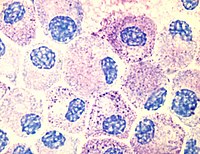
Photo from wikipedia
T‐2 toxin is one of the most toxic trichothecenes and harmful to human health and animal husbandry. The mechanism underlying its growth suppression remains unclear, especially for mitochondrial damage in… Click to show full abstract
T‐2 toxin is one of the most toxic trichothecenes and harmful to human health and animal husbandry. The mechanism underlying its growth suppression remains unclear, especially for mitochondrial damage in human gastric epithelial cells. In the present study, we investigated cell death caused by T‐2 toxin in a human gastric epithelial cell line (GES‐1) and the possible mechanism of T‐2‐induced cytotoxicity. T‐2 strongly reduced the viability of GES‐1 cells in a time‐ and dose‐dependent manner within a small range of concentrations. However, when the concentrations of T‐2 were >40 nM, there was no concentration dependence, only time dependence. Moreover, T‐2 induced apoptosis, with the activation of caspase‐3 in GES‐1 and mitochondrial membrane potential (MMP) decrease and cytochrome c release. T‐2 also resulted in the accumulation of reactive oxygen species (ROS) and DNA damage with a positive signal of p‐H2A.X in GES‐1 cells. While T‐2 caused a MMP decrease, DNA damage and cell death were not blocked by pretreatment with 3 mM glutathione (GSH), a typical scavenger of ROS. The induction of mitochondrial permeability transition pore (mPTP) regulators voltage‐dependent anion channel (VDAC1) and cyclophilin D (CypD) were also observed in T‐2‐treated cells. Interestingly, cyclosporine A (CsA), a CypD inhibitor, significantly reversed the drop in MMP and the DNA damage, as well as ROS accumulation caused by T‐2. Additionally, GES‐1 cell death could also be protected to some extent by 4, 4'‐diisothiocyanatostilbene‐2, 2'‐disulfonic acid (DIDS), an inhibitor of VDAC1, especially the combination of CsA and DIDS, and 3 mM GSH could further enhance the effect of CsA + DIDS on cell viability. In conclusion, our present findings indicate that the T‐2 induced MMP decrease, DNA damage and cell death, as well as ROS accumulation in GES‐1 cells, starts with T‐2 directly perturbing the mitochondria triggering ROS generation by acting on CypD and VDAC1. This study presents a new viewpoint for evaluating the toxicity of T‐2 toxin.
Journal Title: Journal of Applied Toxicology
Year Published: 2020
Link to full text (if available)
Share on Social Media: Sign Up to like & get
recommendations!